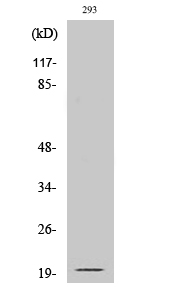Cleaved-Ephrin-A2 (N188) Polyclonal Antibody
- Catalog No.:YC0052
- Applications:WB;ELISA
- Reactivity:Human;Mouse
- Target:
- Ephrin-A2
- Fields:
- >>MAPK signaling pathway;>>Ras signaling pathway;>>Rap1 signaling pathway;>>PI3K-Akt signaling pathway;>>Axon guidance;>>MicroRNAs in cancer
- Gene Name:
- EFNA2
- Protein Name:
- Ephrin-A2
- Human Gene Id:
- 1943
- Human Swiss Prot No:
- O43921
- Mouse Gene Id:
- 13637
- Mouse Swiss Prot No:
- P52801
- Immunogen:
- The antiserum was produced against synthesized peptide derived from human EFNA2. AA range:139-188
- Specificity:
- Cleaved-Ephrin-A2 (N188) Polyclonal Antibody detects endogenous levels of fragment of activated Ephrin-A2 protein resulting from cleavage adjacent to N188.
- Formulation:
- Liquid in PBS containing 50% glycerol, 0.5% BSA and 0.02% sodium azide.
- Source:
- Polyclonal, Rabbit,IgG
- Dilution:
- WB 1:500 - 1:2000. ELISA: 1:20000. Not yet tested in other applications.
- Purification:
- The antibody was affinity-purified from rabbit antiserum by affinity-chromatography using epitope-specific immunogen.
- Concentration:
- 1 mg/ml
- Storage Stability:
- -15°C to -25°C/1 year(Do not lower than -25°C)
- Other Name:
- EFNA2;EPLG6;LERK6;Ephrin-A2;EPH-related receptor tyrosine kinase ligand 6;LERK-6;HEK7 ligand;HEK7-L
- Observed Band(KD):
- 21kD
- Background:
- This gene encodes a member of the ephrin family. The protein is composed of a signal sequence, a receptor-binding region, a spacer region, and a hydrophobic region. The EPH and EPH-related receptors comprise the largest subfamily of receptor protein-tyrosine kinases and have been implicated in mediating developmental events, particularly in the nervous system. Based on their structures and sequence relationships, ephrins are divided into the ephrin-A (EFNA) class, which are anchored to the membrane by a glycosylphosphatidylinositol linkage, and the ephrin-B (EFNB) class, which are transmembrane proteins. Posttranslational modifications determine whether this protein localizes to the nucleus or the cytoplasm. [provided by RefSeq, Jul 2008],
- Function:
- similarity:Belongs to the ephrin family.,subunit:Binds to the receptor tyrosine kinases EPHA3, EPHA4 and EPHA5.,
- Subcellular Location:
- Cell membrane ; Lipid-anchor, GPI-anchor .
- Expression:
- Brain,
- June 19-2018
- WESTERN IMMUNOBLOTTING PROTOCOL
- June 19-2018
- IMMUNOHISTOCHEMISTRY-PARAFFIN PROTOCOL
- June 19-2018
- IMMUNOFLUORESCENCE PROTOCOL
- September 08-2020
- FLOW-CYTOMEYRT-PROTOCOL
- May 20-2022
- Cell-Based ELISA│解您多样本WB检测之困扰
- July 13-2018
- CELL-BASED-ELISA-PROTOCOL-FOR-ACETYL-PROTEIN
- July 13-2018
- CELL-BASED-ELISA-PROTOCOL-FOR-PHOSPHO-PROTEIN
- July 13-2018
- Antibody-FAQs
- Products Images

- Western Blot analysis of various cells using Cleaved-Ephrin-A2 (N188) Polyclonal Antibody

- Western blot analysis of lysates from 293 cells, treated with etoposide 25uM 1h, using EFNA2 (Cleaved-Asn188) Antibody. The lane on the right is blocked with the synthesized peptide.



